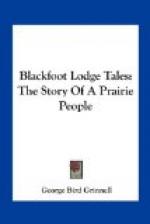The lodges of the chiefs of the I-kun-uh’-kah-tsi which were within the circle served as lounging and eating places for such members of the bands as were on duty, and were council lodges or places for idling, as the occasion demanded.
When the camp moved, the Blood gens moved first and was followed by the White Breast gens, and so on around the circle to number 24. On camping, the Bloods camped first, and the others after them in the order indicated, number 24 camping last and closing up the circle. DIAGRAM OF OLD-TIME PIEGAN CAMP, SAY 1850 TO 1855. TWENTY-FOUR LODGES OF CHIEFS OF THE GENTES ABOUT THE OUTER CIRCLE.
The inner circle shows lodges of chiefs of certain bands of the I-kun-uh’-kah-tsi.
[Illustration]
GENTES OF THE PI-KUN’-I
1. Blood People.
2. White Breasts.
3. Dried Meat.
4. Black Patched Moccasins.
5. Black Fat Roasters.
6. Early Finished Eating.
7. Don’t Laugh.
8. Fat Roasters.
9. Black Doors.
10. Lone Eaters.
11. Skunks.
12. Seldom Lonesome.
13. Obstinate.
14. Lone Fighters.
15. Small Robes.
16. Big Topknots.
17. Worm People.
18. Small Brittle Fat.
19. Buffalo Dung.
20. No Parfleche.
21. Kill Close Bye
22. All Chiefs.
23. Red Round Robes.
24. Many Medicines.
BANDS OF THE I-KUN-UH’-KAH-TSI
a. All Crazy Dogs. b. Dogs. c. Tails. d. Kit-foxes. e. Raven Bearers. f. Braves. g. Mosquitoes. h. Soldiers. i. Doves.
HUNTING
The Blackfoot country probably contained more game and in greater variety than any other part of the continent. Theirs was a land whose physical characteristics presented sharp contrasts. There were far-stretching grassy prairies, affording rich pasturage for the buffalo and the antelope; rough breaks and bad lands for the climbing mountain sheep; wooded buttes, loved by the mule deer; timbered river bottoms, where the white-tailed deer and the elk could browse and hide; narrow, swampy valleys for the moose; and snow-patched, glittering pinnacles of rock, over which the sure-footed white goat took his deliberate way. The climate varied from arid to humid; the game of the prairie, the timber, and the rocks, found places suited to their habits. Fur-bearing animals abounded. Noisy hordes of wild fowl passed north and south in their migrations, and many stopped here to breed.




